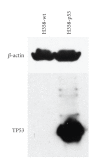Modulation of the ribonucleotide reductase-antimetabolite drug interaction in cancer cell lines
- PMID: 20976259
- PMCID: PMC2952906
- DOI: 10.4061/2010/597098
Modulation of the ribonucleotide reductase-antimetabolite drug interaction in cancer cell lines
Abstract
RRM1 is a determinant of gemcitabine efficacy in cancer patients. However, the precision of predicting tumor response based on RRM1 levels is not optimal. We used gene-specific overexpression and RNA interference to assess RRM1's impact on different classes of cytotoxic agents, on drug-drug interactions, and the modulating impact of other molecular and cellular parameters. RRM1 was the dominant determinant of gemcitabine efficacy in various cancer cell lines. RRM1 also impacted the efficacy of other antimetabolite agents. It did not disrupt the interaction of two cytotoxic agents when combined. Cell lines with truncation, deletion, and null status of p53 were resistant to gemcitabine without apparent relationship to RRM1 levels. Pemetrexed and carboplatin sensitivity did not appear to be related to p53 mutation status. The impact of p53 mutations in patients treated with gemcitabine should be studied in prospective clinical trials to develop a model with improved precision of predicting drug efficacy.
Figures




Similar articles
-
Potent subunit-specific effects on cell growth and drug sensitivity from optimised siRNA-mediated silencing of ribonucleotide reductase.J RNAi Gene Silencing. 2009 Mar 9;5(1):321-30. J RNAi Gene Silencing. 2009. PMID: 19771229 Free PMC article.
-
Ribonucleotide Reductase Catalytic Subunit M1 (RRM1) as a Novel Therapeutic Target in Multiple Myeloma.Clin Cancer Res. 2017 Sep 1;23(17):5225-5237. doi: 10.1158/1078-0432.CCR-17-0263. Epub 2017 Apr 25. Clin Cancer Res. 2017. PMID: 28442502 Free PMC article.
-
Ribonucleotide reductase M1 expression in intrahepatic cholangiocarcinoma.Hepatogastroenterology. 2011 Sep-Oct;58(110-111):1659-63. doi: 10.5754/hge11175. Epub 2011 Jul 15. Hepatogastroenterology. 2011. PMID: 21940346
-
Prognostic value of ribonucleotide reductase subunit M1 (RRM1) in non-small cell lung cancer: A meta-analysis.Clin Chim Acta. 2018 Oct;485:67-73. doi: 10.1016/j.cca.2018.05.042. Epub 2018 May 25. Clin Chim Acta. 2018. PMID: 29803896 Review.
-
The ribonucleotide reductase large subunit (RRM1) as a predictive factor in patients with cancer.Lancet Oncol. 2011 Jul;12(7):693-702. doi: 10.1016/S1470-2045(10)70244-8. Epub 2010 Dec 14. Lancet Oncol. 2011. PMID: 21163702 Review.
Cited by
-
Randomized international phase III trial of ERCC1 and RRM1 expression-based chemotherapy versus gemcitabine/carboplatin in advanced non-small-cell lung cancer.J Clin Oncol. 2013 Jul 1;31(19):2404-12. doi: 10.1200/JCO.2012.46.9783. Epub 2013 May 20. J Clin Oncol. 2013. PMID: 23690416 Free PMC article. Clinical Trial.
-
Depletion of HDAC6 enhances cisplatin-induced DNA damage and apoptosis in non-small cell lung cancer cells.PLoS One. 2012;7(9):e44265. doi: 10.1371/journal.pone.0044265. Epub 2012 Sep 5. PLoS One. 2012. PMID: 22957056 Free PMC article.
-
A kinome screen identifies checkpoint kinase 1 (CHK1) as a sensitizer for RRM1-dependent gemcitabine efficacy.PLoS One. 2013;8(3):e58091. doi: 10.1371/journal.pone.0058091. Epub 2013 Mar 4. PLoS One. 2013. PMID: 23483975 Free PMC article.
-
Chronic p27Kip1 Induction by Dexamethasone Causes Senescence Phenotype and Permanent Cell Cycle Blockade in Lung Adenocarcinoma Cells Over-expressing Glucocorticoid Receptor.Sci Rep. 2018 Oct 30;8(1):16006. doi: 10.1038/s41598-018-34475-8. Sci Rep. 2018. PMID: 30375484 Free PMC article.
-
Doxycycline potentiates the anti-proliferation effects of gemcitabine in pancreatic cancer cells.Am J Cancer Res. 2021 Jul 15;11(7):3515-3536. eCollection 2021. Am J Cancer Res. 2021. PMID: 34354858 Free PMC article.
References
-
- Davidson JD, Ma L, Flagella M, Geeganage S, Gelbert LM, Slapak CA. An increase in the expression of ribonucleotide reductase large subunit 1 is associated with gemcitabine resistance in non-small cell lung cancer cell lines. Cancer Research. 2004;64(11):3761–3766. - PubMed
-
- Rosell R, Danenberg KD, Alberola V, et al. Ribonucleotide reductase messenger RNA expression and survival in gemcitabine/cisplatin-treated advanced non-small cell lung cancer patients. Clinical Cancer Research. 2004;10(4):1318–1325. - PubMed
-
- Bergman AM, Eijk PP, Ruiz van Haperen VWT, et al. In vivo induction of resistance to gemcitabine results in increased expression of ribonucleotide reductase subunit M1 as the major determinant. Cancer Research. 2005;65(20):9510–9516. - PubMed
-
- Bepler G, Kusmartseva I, Sharma S, et al. RRM1 modulated in vitro and in vivo efficacy of gemcitabine and platinum in non-small-cell lung cancer. Journal of Clinical Oncology. 2006;24(29):4731–4737. - PubMed
-
- Nakahira S, Nakamori S, Tsujie M, et al. Involvement of ribonucleotide reductase M1 subunit overexpression in gemcitabine resistance of human pancreatic cancer. International Journal of Cancer. 2007;120(6):1355–1363. - PubMed
Grants and funding
LinkOut - more resources
Full Text Sources
Research Materials
Miscellaneous

